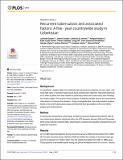Recurrent tuberculosis and associated factors : a five-year countrywide study in Uzbekistan
Abstract
Background: In Uzbekistan, despite stable and relatively high tuberculosis treatment success rates, relatively high rates of recurrent tuberculosis have recently been reported. Recurrent tuberculosis is when a patient who was treated for pulmonary tuberculosis and cured, later develops the disease again. This requires closer analysis to identify possible causes and recommend interventions to improve the situation. Using countrywide data, this study aimed to analyse trends in recurrent tuberculosis cases and describe their associations with socio-demographic and clinical factors. Method: Countrywide retrospective cohort study comparing recurrent tuberculosis patients with all new tuberculosis patients registered within the NTP between January 2006 and December 2010 using routinely collected data. Determinants studied were baseline characteristics and treatment outcomes. Results: Of 107,380 registered patients during the period January 2006 and December 2010, 9358 (8.7%) were recurrent cases. Between 2006 and 2008, the number of recurrent cases per annum increased from 1530 to 2081, then fell slightly thereafter from 2081 to 1888 cases. The proportion of all notified cases during this period increased from 6.5% to 9.9%. Factors associated with recurrent tuberculosis included age (35–55 years old), having smear positive pulmonary tuberculosis, residing in certain areas of Uzbekistan, having particular co-morbidities (including chronic obstructive pulmonary disease and HIV), and being unemployed, a pensioner or disabled. Recurrent tuberculosis patients also had a higher likelihood of having an unfavourable treatment outcome. Conclusion: Despite signs of declining national tuberculosis notifications between 2006 and 2010, the relative proportion of recurrent cases appears to have increased. These findings, together with the identification of possible risk factors associated with recurrent tuberculosis, highlight various areas where Uzbekistan needs to focus its tuberculosis control efforts, particularly in light of the country’s rapidly emerging multi drug resistant tuberculosis epidemic.
Citation
Gadoev , J , Asadov , D , Harries , A D , Parpieva , N , Tayler-Smith , K , Isaakidis , P , Ali , E , Hinderaker , S G , Ogtay , G , Ramsay , A , Jalolov , A & Dara , M 2017 , ' Recurrent tuberculosis and associated factors : a five-year countrywide study in Uzbekistan ' , PLoS One , vol. 12 , no. 5 , e0176473 . https://doi.org/10.1371/journal.pone.0176473
Publication
PLoS One
Status
Peer reviewed
ISSN
1932-6203Type
Journal article
Collections
Items in the St Andrews Research Repository are protected by copyright, with all rights reserved, unless otherwise indicated.

